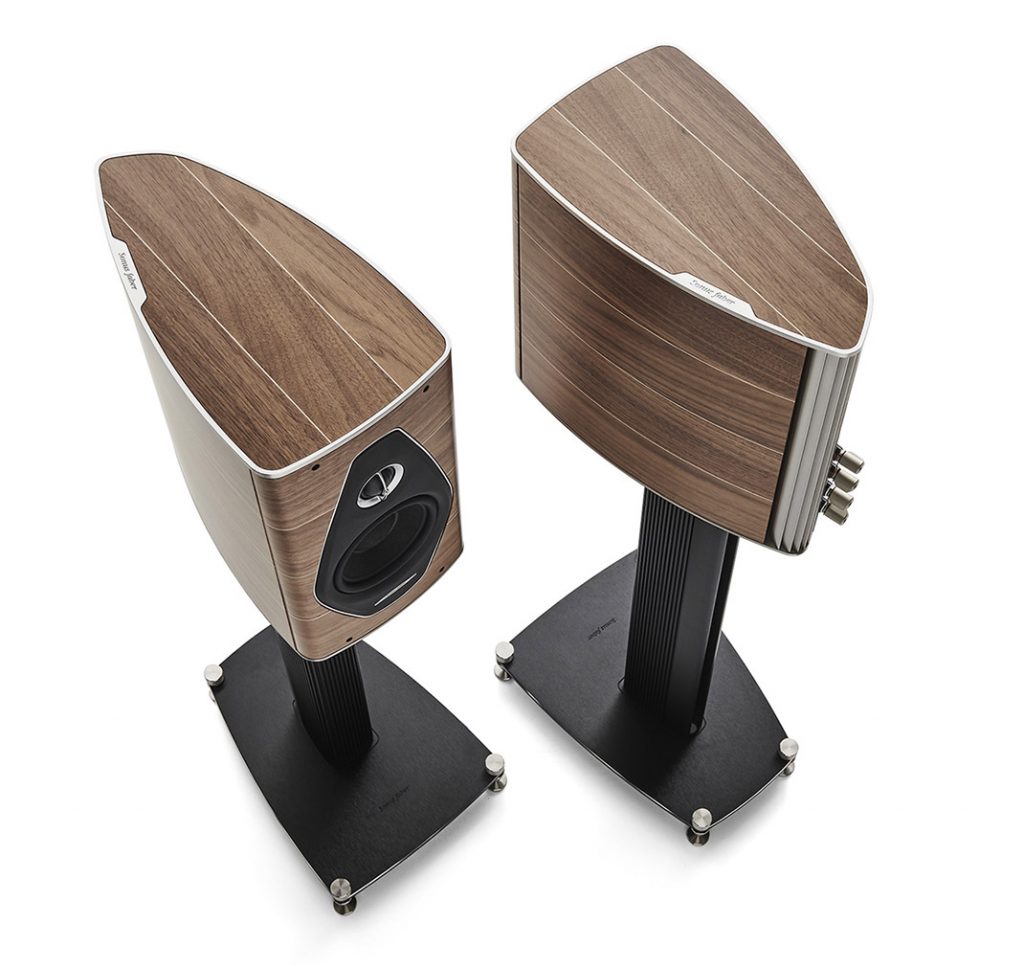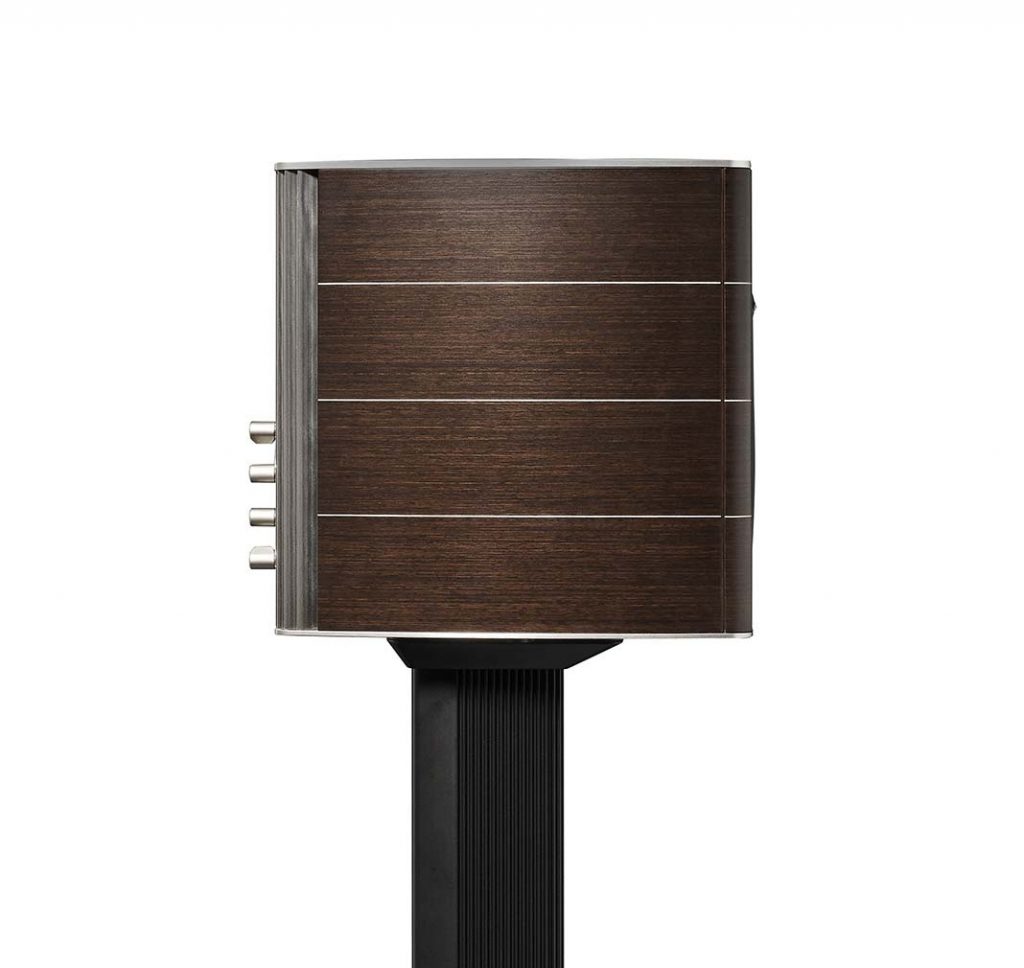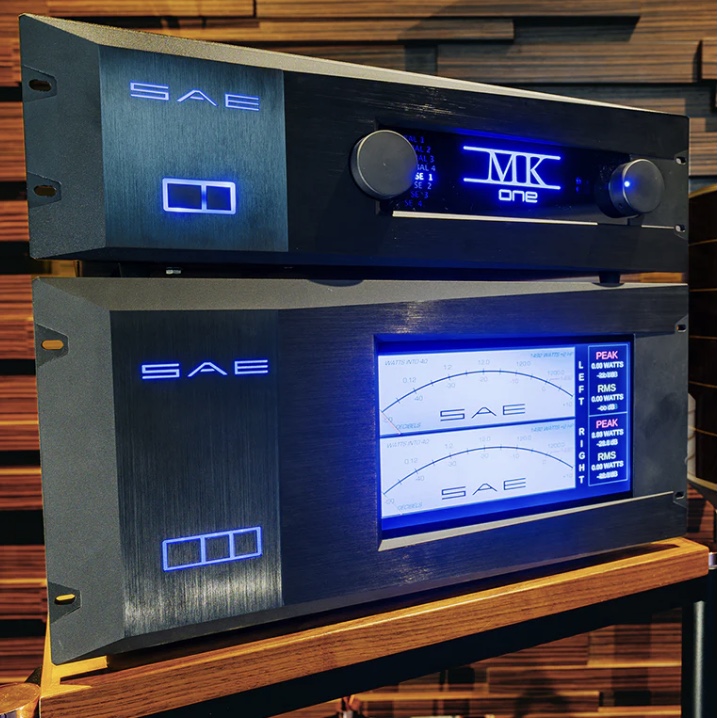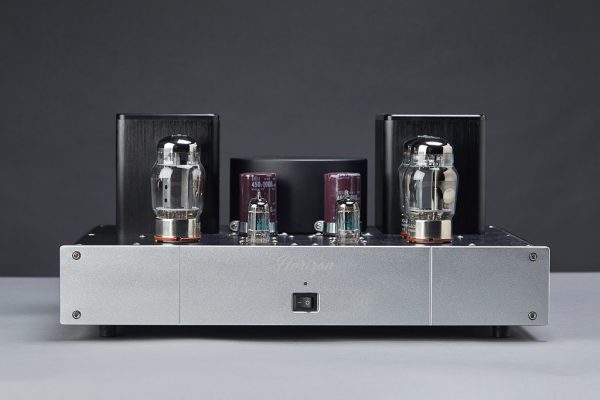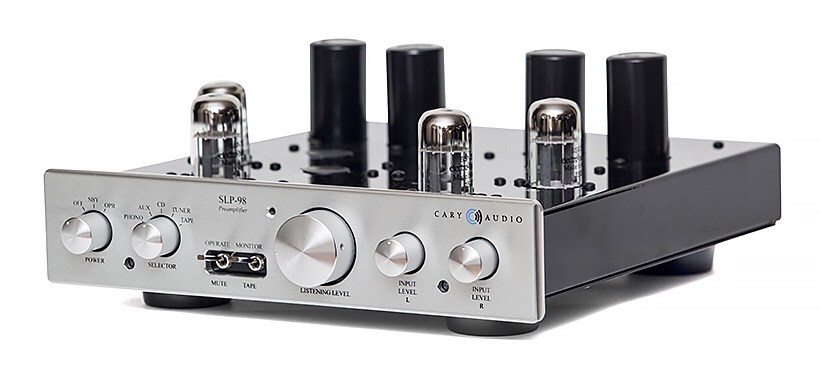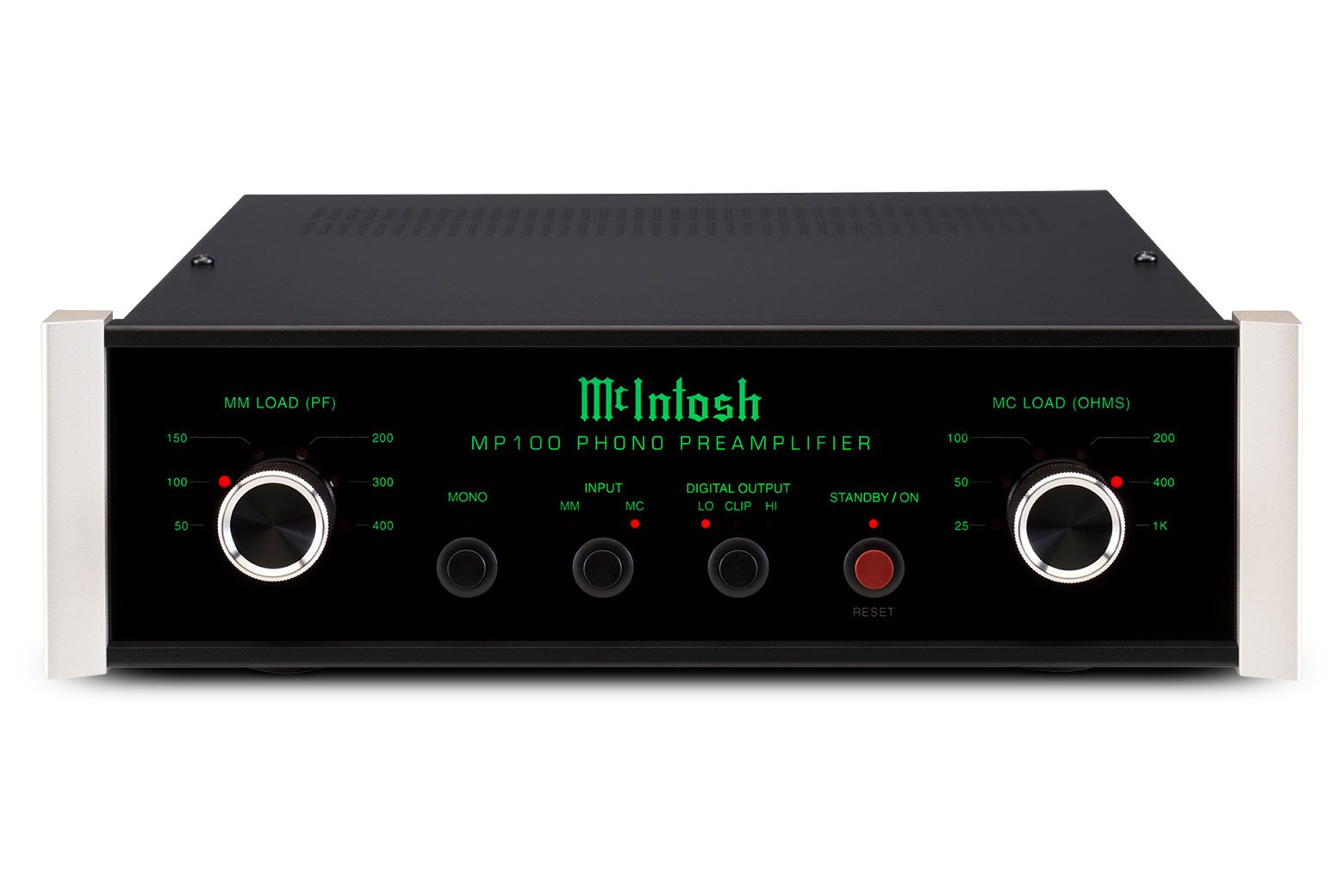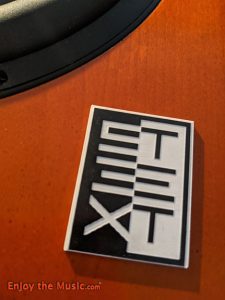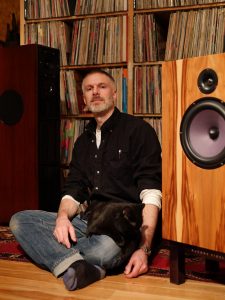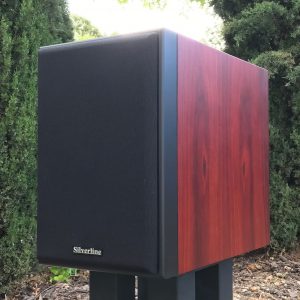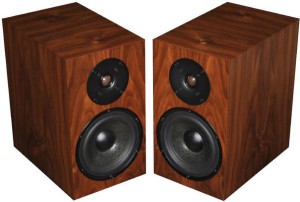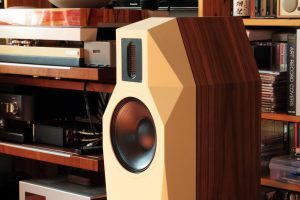Sonus faber is not a stranger to most people in the high end audio world. They are well known for creating some of the most visually striking and best sounding speakers available. My very first experience with the brand was a set of Sonus faber Extrema stand mount monitors at a store in Denver, they were being driven by a set of Conrad Johnson amps and Conrad Johnson matching preamp, and the source was a VPI TNT. The sound was magical, and the speakers seemed to have an incredible range, the depth, breadth, and height of the soundstage that was incredible. The absolute disappearing act of the speakers was on par with my experience with Cary 805/ProAc for the first time. I have always been impressed with Sonus faber's speakers at shows, and in homes where the owner was able to afford the speakers.
The Olympica Nova 1 is a new offering by Sonus faber as part of their Olympica Line. The Olympica range seems to fit squarely in the middle of Sonus faber's current collections. The review pair arrived with the matching Olympica dedicated stands. The stands weighed only slightly less than the speakers. That is a testament to the build quality of those stands.
When the two boxes arrived I eagerly unboxed the goodies inside. I always get exited about gear that does not put me in fear of further back surgeries from lifting and placing them. Four of those surgeries is quite enough thank you.
The speakers came in Walnut finish, but Wenge is a lovely option. Darker than the walnut, but both are actually fabulous finishes.
Sonus faber calls them a two way, full para-aperiodic vented box "Stealth Ultraflex," stand mount loudspeaker system. There nominal impedance is a friendly 4 ohm. While Sonus says that at 87dB sensitivity, a mere 35-watts is enough to drive them, I found that more is definitely better with these speakers. Driving them with my 50 watt per channel Cary 805 SET amps was far less satisfying than driving them with the Paradox Pulse 100 watt per channel solid state amps, or my 200 watts per side Jolida Music envoys. Not that it was bad, it just took so much more to drive them to a satisfying listening level.
More of the specs:
- Drivers - Tweeter: H28 XTR3, Neodymium "cup design" motor system with DAD™, Ø 28 mm
- Midrange/woofer: MW15 XTR2-04, CCAW wire on a "eddy current free" voice coil, Ø 150 mm
- Crossover - 2500 Hz
- Frequency Response - 45 Hz – 35.000 Hz
- Sensitivity - 87 dB SPL (2.83V/1 m)
- Recommended amplifier power - 35 to 250 watts without clipping
- Dimensions - (HxWxD mm) 355 (1078 stand included) x 199,5 (282 stand included) x 395 mm
- 14 (42.4 stand included) x 7.8 (11.1 stand included) x 15.5 in
- Weight - 10,5 kg - net weight (17,1 Kg stand included)
- 23.1 - net weight (37.6 lb stand included)
The lack of flat and parallel walls improves enclosure performance, and maintains the typical asymmetrical Lute shape of first generation Olympica. The asymmetrical shape of the cabinet is an original design concept that allows versatile positioning of the speakers to tune the bass response in any room. Inspired by nature, the lines follow the flow of a circular spiral motion, achieving a more organic cabinet structure. No longer just a functional element added to handle airflow, the reflex duct is now fully integrated into the cabinet, further improving the speed and transparency of sound.
The cabinet sides, the front baffle, and the top are made of walnut or wenge hand finished natural wood, and set in a solid cast aluminum plates.
The entire structure of the cabinet has been redesigned. Similar to the Homage Tradition and Reference collections, the walls are made with eight layers of wood, providing the cabinet with extreme rigidity.
The crossover, according to Sonus, implements Paracross Topology making it less sensitive to radio-frequency interference. This is supposed to improve transient response and lower floor noise. The filtering topology features new Clarity Cap capacitors customized for Sonus faber.
The port is a vertical and finned affair. Made from a solid piece of extruded aluminum that completes the Stealth Ultraflex (TM) system, an extremely low turbulence porting system that comes from the Homage Tradition series. Favoring the profile of sea waves, the structure facilitates airflow through the duct, while controlling its speed and reducing distortion causing turbulence. In other words no chuffing.
As is common with most higher order speakers these days, the Nova 1 is equipped with two sets of speaker connects to allow for bi-wiring or bi-amping, both of which I tried during the speaker's time in my system. One design feature of these binding posts is something that I just found to be simply genius. The knobs on the binding posts mirror the shape of the cabinet. Not a insignificant little design factor, but a very functional one. I have never found a set of binding posts that tightened so easily, and were so finger friendly to use. It is these small, functional details that make the Sonus faber speakers exceptionally well designed from top to bottom.
Another simple design item that impacts the overall look and feel is the leather front panel covering. This is a beautiful piece of Italian leather, and gives a softened look that makes the front of the speaker look more elegant. If for no other reason than the aesthetic it would be a lovely addition. However Sonus faber rarely does things that are simply to make a speaker just look better. Many argue that there is significant reflection off the front baffle of a speaker. To deal with this, one option is that you create a soft surface on the baffle, soft enough to take care of the critical section which is from low midrange to upper midrange (250-4kHz).
Do all these design parameters work to make the speakers sound better? In short, it seems so because overall these speakers were absolutely delightful to listen too.
"The 28 mm silk soft dome tweeter features the DAD™ technology (Damped Apex Dome™) that enhances the smoothness and extension in the high frequency by applying local dampening to the apex typically responsible for anti-phase behavior of soft dome diaphragms. The DAD™ structure has been totally redesigned; a solid piece of aluminum die-cast includes both arch and ring on the dome to increase the strength and accuracy of the system." This tweeter produces wonderful high frequencies from 2500 Hz upward. The highs are crystal clear in nature, but delivered without grain, hard edge, or tinny qualities. Their ability to produce sounds such as chimes and cymbals without any annoying, fatigue inducing edge is stellar, and the decay from such sonics is outstanding. These tweeters produce some of the finest high frequencies I have heard in this price point. Smooth, lightning fast, and liquid delivery makes for hours upon hours of enjoyable listening.
"The midwoofer has the same construction of the midrange of its siblings, with 2 main differences. The Dust-cap, coated in fabric to provide an air-tight seal to maximize the moving surface, increases air movement without distortion. The moving coil optimized for bass performance with much longer throw, improves driver excursion and the overall magnetic field." The midwoofer provides absolutely beautiful midrange delivery, especially in vocals, the voices are creamy smooth. The speaker delivers mid range and mid bass exceptionally well within the stated range of the driver. The frequency response is flat and consistent down to the stated 45Hz flooring. After that I found the bass dropped off steeply. It is articulate within the stated range of 2500Hz to the bottom end at 45Hz, and while slightly warm in comparison to some other speakers I have reviewed, it is precisely what makes this speaker so easy to listen to for long periods of time.
For most of the review I listened to the speaker without any augmentation from a subwoofer. However I did try bi-amping the speaker, with the bass being fed into the woofer cabinets of my VSR4s. That produced significantly more bass than the speakers themselves produce, and I am quite comfortable saying that this speaker would definitely be satisfying just on their own to a great percentage of those looking for a stand mount monitor because of their incredible ability to disappear in the room leaving only the magic of the music. I also feel that the speakers would blend well with a sub for those looking to get down to that 20-25Hz of low end.
In listening sessions, I mainly stuck with the high wattage Jolida Music Envoys (an amp no longer in production, which is a huge shame) at 200-watts a side to get the most dynamics out of the speakers, so listening notes will come from those sessions. That being said, the Paradox Pulse monos were capable of driving them to satisfying levels with ease. the Cary 805s struggled a little bit more with the 87dB sensitivity when it came to larger scale music.
Toy Matinee was a studio band from the 90s, a collaboration between multi-talented and multi-instrumentalist and vocalist Kevin Gilbert (alternately credited with the discovery and promotion of then girlfriend Sheryl Crow), producer, writer, and keyboardist extraordinaire Patrick Leonard (Madonna's long time songwriting and production partner), and gifted and touring bassist Guy Pratt. The debut, self titled album Toy Matinee (Reprise 1990), never quite took off beyond developing a fiercely loyal cult (I am a member), and was one of the most fascinating albums of the decade. Unfortunately, Gilbert's untimely death prevented this trio from a follow up. (There was a follow up under the band name, but it substituted Richard Page for Gilbert, and should have taken on a completely different name due to loss of Gilbert who wrote much of the music). The track "The Toy Matinee'" is perhaps the tour de force of the album that combines swirling sonic keyboards and a Beatlesque take. It is rather haunting, and drags one into the circus of a vaudeville type story of a ringmaster appeasing a crowd. Some of the best double entendre's in rock play against a stark musical background. The keyboards provide both a musical and percussive layering that support the vocals and guitar opposition. Through the Nova 1 speakers, the detail was absolutely amazing. Decay of notes fell away with clarity and sustain. The highs were liquid and without a bit of grain or edge, the vocals were like velvet. The sound of the wind up toy was sublime. Perhaps one of the best renditions of the song I have heard at this price point. The bass was modest on the original recording (later remastered in 1999 and released in 2001), the Nova handled it admirably and was not the least bit phased by all but the deepest notes.
On the Mike Greene Band release Pale Pale Moon, (1975 General Recording Corporation GA10013) the title track is a very upbeat jazz/fusion track featuring scat vocals, keyboards, and saxophones by Mike, and a searing guitar solo by David Michael that leaves me with the feeling of sailing on the open ocean! (Don't ask me why, but that is what I always think of when listening to this track. I was in college when I first bought it, and therein lies explanation enough). If you have never heard the album, try to find it. It is available digitally, but the original vinyl is one of my all time favorites. The keyboards, bass, and percussion came through in their own space, and were clearly separated on the expansive soundstage. You can easily tell the musicians and their positions when coming thought the Nova 1s, and the guitar was front and center as it should have been replacing Mike's vocals as if David simply stepped in front of Mike to take the solo spotlight. Absolutely delightful. Every note just came through and drew you into the performance. The engineering could have been slightly better, but was on par for 1975. It would be interesting to hear the tracks re-engineered today. Either way, the Nova 1 speaker delivered the Sonics as well as I have heard any monitor ever do it.
On Shirley Horn's "Quietly There" from the recording Here's To Life (Verve 314511879), the intimacy was astonishing. Arranged by Johnny Mandel and recorded in 1991, the track features Shirley on vocals and piano, Charles Ables on bass, Steve Williams on drums, and a solo by the the outstanding Wynton Marsalis on trumpet. This four piece ensemble is augmented by strings arranged and conducted by Mandel. Shirley's vocals are the driving performance on the track, and properly supported by the musicians without drawing away from the vocalist. This is a one of those tracks that when reproduced on the right system leaves you feeling so deeply impacted and sorrowful for the singer who is delivering one of the most most heartfelt performances I have heard. She is telling the story of deep regret for letting the perfect mate get away without ever letting them know how deeply she loved them, and how painful it is to know they are no longer waiting for her at home. I must have listened to this track a dozen times while I had the Nova 1s in the system. The emotion that her vocals delivered was so intimate, and so detailed that it brought me to tears at one point. (I get every involved with the music if it is delivered properly). The pain and suffering of being left through your own inability to connect with one you love has to be one of the worst there is for a human being. It came through so clearly in her performance and was just so powerful. What more can you ask from a speaker?
Another very telling recording is from Willie Nelson's Stardust album (Mobile Fidelity Sound Labs vinyl edition) originally released in 1978 by Columbia. It was a number one album in the Country category, more for the artist than the style of the music. The title track is, in my opinion, one of his finest recordings. On the MFSL recording the quality is breathtaking. Rendered through the Sonus faber Nova 1, the first thing that stood out was the height of the soundstage and Willie's placement dead center. His voice is just so intimate, and you can almost feel the breath when he sings. That is the kind of detail we all strive for when selecting components. I could sense the flesh on the nylon strings of his guitar. It is a stark recording, but the quality is stellar. The Nova 1 excelled in the midrange with speed, a vicious tonal palette, and a very noticeable wide-band contrast.
Deep into my listening sessions with these speakers, when they were fully run in, I threw on the reissue of Wes Montgomery's The Incredible Jazz Guitar of Wes Montgomery, featuring Tommy Flanagan, Percy Heath, and Albert Heath (180 gram WaxTime Records 950674). This is a fantastic album pressed in red vinyl, of which the quality, which can be slightly less on colored vinyl records of the past, is exceptional.
The Heath brothers provide the solid rhythm section of drums and bass to underpin Flanagan's piano, and Wes's flawless guitar playing throughout the album. I learned of Wes very early in my childhood when I started playing guitar at the age of eight. (I stink, and could never even picture playing like Wes). I have loved everything I have ever heard from this virtuoso. It followed that I would learn to to love George Benson's playing, as he was a disciple of Wes. Wes had a unique styling in that he used his thumb to play rather than a pick. There is a distinct difference in the attack of a guitar string when it is played sans a pick that any guitar player will hear immediately on a recording that is presented well, and through a set of speakers than can deliver that detail. One night, while doing my listening session, my wife had gone to bed early so I lowered the sound level for the remainder of the evening. That was when I discovered just how good the Sonus faber Nova 1 was with low level dynamics. I could immediately recognize that distinct flesh on the strings, and the slight sound of fingers sliding up and down the fingerboard. I usually like the levels up when I do critical listening, but was so pleased that so much info still came front and center at lower listening levels. Anyone who has to be considerate of a partner who turns in early, someone who has small children, or neighbors who share walls, would immediately find a good deal of satisfaction with the Nova 1 at those lower levels. That is a stellar trait for any speaker.
The matching speakers stands at $1200 are not cheap, but they are a must. They sit at the exact right height, add to the mass, and match the speaker perfectly. At this price point it would simply be foolish to not opt for them. They proved a rigid, firm, and very stable mounting for the speakers. I have some very heavy stands that are mass loaded with bags of lead, but I would have still opted for the matching stands for all of the mentioned benefits, and also because visually they complement the speakers perfectly. One can never discount the visual improvement over my industrial looking stands.
The plain and simple summary is that anyone, and I do mean anyone, looking for a stand mount monitor in this price range should most definitely audition the Sonus faber Nova 1. It is on my list of possibilities, as I have recently started looking for a new set of monitors. Don't know how I could be any more positive than that, other than it was very, very difficult to box them up and send them back. Stay tuned for a possible piece on the Elect Amator III coming soon.
Olympica Nova 1
Retail: $6500, $1200 for stands
Sonus faber
American Distribution
SUMIKO VERTICAL CUBED
6655 Wedgwood Road N. Suite 115
Maple Grove, MINNESOTA
USA MN55311
51.843.4500





